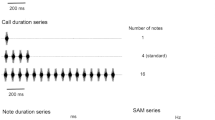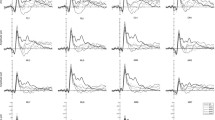Summary
Neural activity correlated with electrically-evoked, mating calling movements of the larynx was recorded from the region of the main sensory nucleus of the trigeminal in the northern leopard frog (Figs. 1, 3–5). The probable importance of this area for calling was shown further by the facts that stimulation through an electrode from which correlates had been recorded evoked release calling activity (Fig. 6) and that bilateral, electrolytic lesions through such electrodes abolished electrically-evoked, mating calling movements of the larynx (Fig. 3). The neural correlates survived complete denervation of the brain stem and their patterns were independent of the pattern of the evoking stimulus (Fig. 4). Therefore, the patterns of these correlates were generated within the brain stem. Neural correlates and laryngeal electromyograms typical of mating calling could be recorded after removal of the preoptic area, showing that that structure was not necessary for generation of mating calling patterns (Fig. 5). A revised model of the neural mechanisms of calling is presented (Fig. 8). This model postulates a vocal-phase pulse generator in the region of the main sensory nuclei V. This generator, once triggered, then activates more posterior breathing circuits and modifies their activity to produce calling, rather than breathing movements.
Similar content being viewed by others
References
Fuller, P. M., Ebbesson, S. O. E.: Central projections of the trigeminal nerve in the bull frog (Rana catesbeiana). J. comp. Neurol.152, 193–200 (1973)
Joseph, B. S., King, R. B., Whitlock, D. G.: Central distribution of trigeminal primary afferent fibers in anuran amphibians Anat Rec.160, 719–728 (1968)
Kelley, D. B., Pfaff, D. W., Morrell, J. I.: Radioactivity in the brain of male South African clawed frogs (Xenopus laevis) following injection of H3-testosterone. An autoradiographic study. Amer. Zoologist13, 1287 (1973)
Larsell, O.: The cerebellum of the frog. J. comp. Neurol.36, 89–112 (1923)
Larsell, O.: The development of the cerebellum in the frog (Hyla regilla) in relation to the vestibular and lateral line systems. J. comp. Neurol.39, 249–289 (1925)
Prior, D. J., Fuller, P. M.: The use of a cobalt iontophoresis technique for identification of the mesencephalic trigeminal nucleus. Brain Res.64, 472–475 (1973)
Röthig, P.: Beiträge zum Studium des Zentralnervensystems der Wirbeltiere. XI. Ueber die Faserzüge im Mittelhirn, Kleinhirn, und der Medulla oblongata der Urodelen und Anuren. Z. mikr.-anat. Forsch.10, 381–472 (1927)
Woodburne, R. T.: A phylogenetic consideration of the primary and secondary centers and connections of the trigeminal complex in a series of vertebrates. J. comp. Neurol.65, 403–501 (1936)
Author information
Authors and Affiliations
Rights and permissions
About this article
Cite this article
Schmidt, R.S. Neural correlates of frog calling. J. Comp. Physiol. 92, 229–254 (1974). https://doi.org/10.1007/BF00696613
Received:
Issue Date:
DOI: https://doi.org/10.1007/BF00696613




